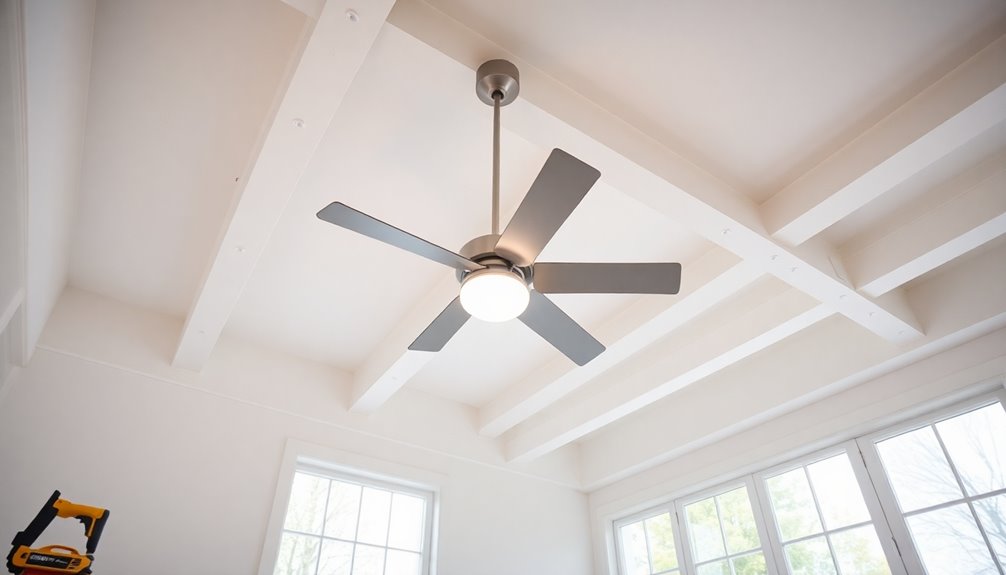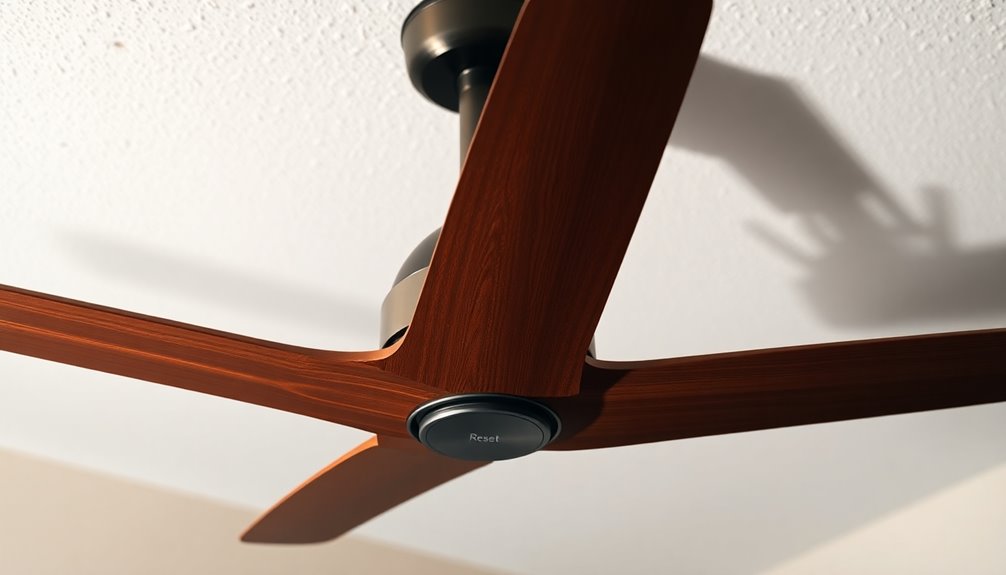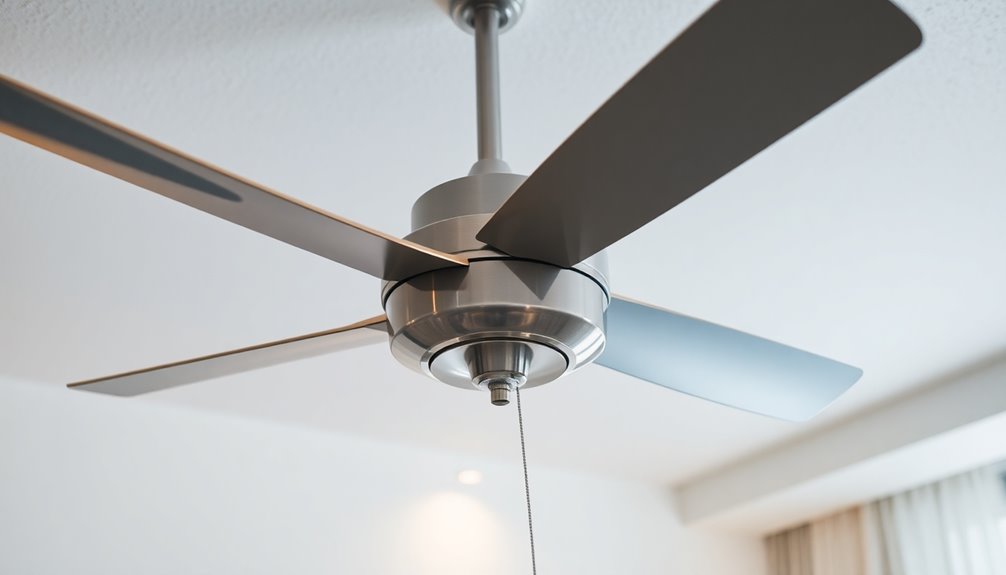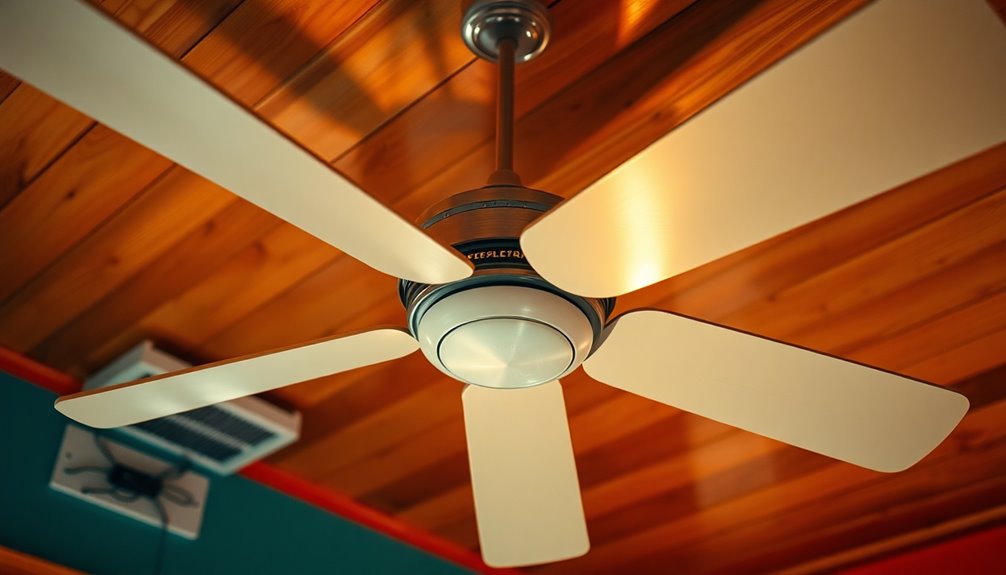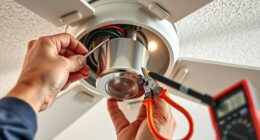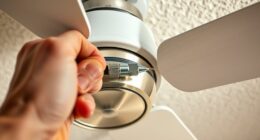Reversing your ceiling fan's direction can greatly enhance your comfort and energy efficiency year-round. In winter, switching it to clockwise helps push warm air down, keeping your space cozy without overworking your heating system. In summer, a counterclockwise rotation creates a cooling downdraft, making you feel cooler and allowing you to raise the thermostat a few degrees. This simple adjustment can save you on energy bills and reduce reliance on heating and cooling systems. It's an easy step toward a more comfortable home, and there's plenty more to explore on maximizing your fan's benefits.
Key Takeaways
- Reversing the ceiling fan in winter helps distribute warm air from the ceiling, enhancing comfort and energy efficiency.
- In summer, counterclockwise rotation creates a cooling downdraft, making it feel cooler and allowing for higher thermostat settings.
- Running the fan in winter can reduce heating costs by up to 10%, leading to significant energy savings.
- Proper fan direction can lead to a potential 15% reduction in overall utility bills through optimized air circulation.
- Selecting the right fan size and direction improves air distribution, enhancing comfort throughout the year.
Ceiling Fan Direction in Winter
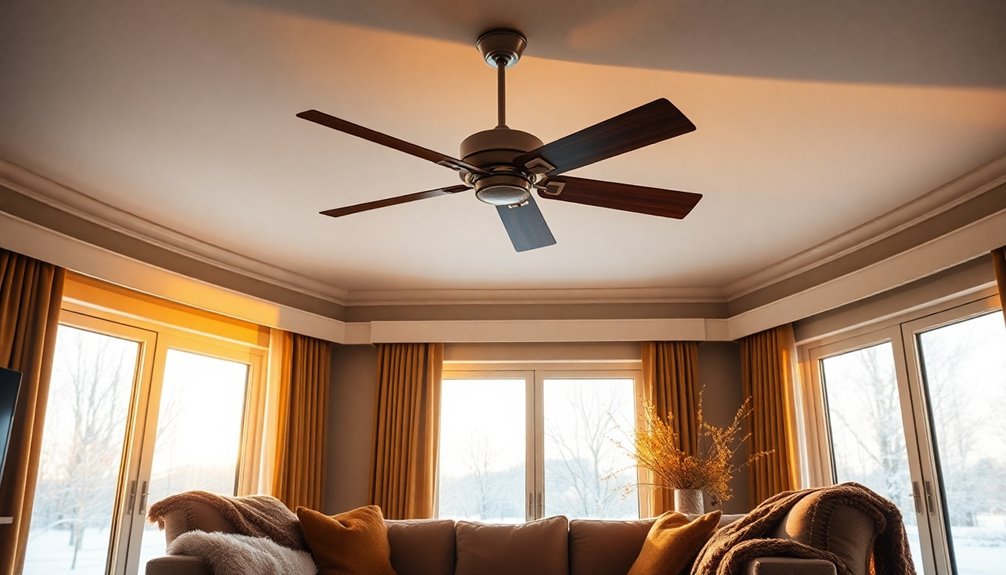
In winter, you should set your ceiling fan to rotate clockwise to maximize warmth in your home.
This ceiling fan direction effectively circulates warm air that rises to the ceiling, pushing it back down into your living space. When you reverse your ceiling fan, it creates an updraft that helps maintain a consistent temperature throughout the room.
Running the fan on a low speed during winter prevents uncomfortable drafts while still promoting warmth distribution.
You'll notice that the clockwise motion of the blades, which appears to move to the right when viewed from below, aids in circulating warm air efficiently without causing downdrafts.
Benefits of Winter Fan Mode
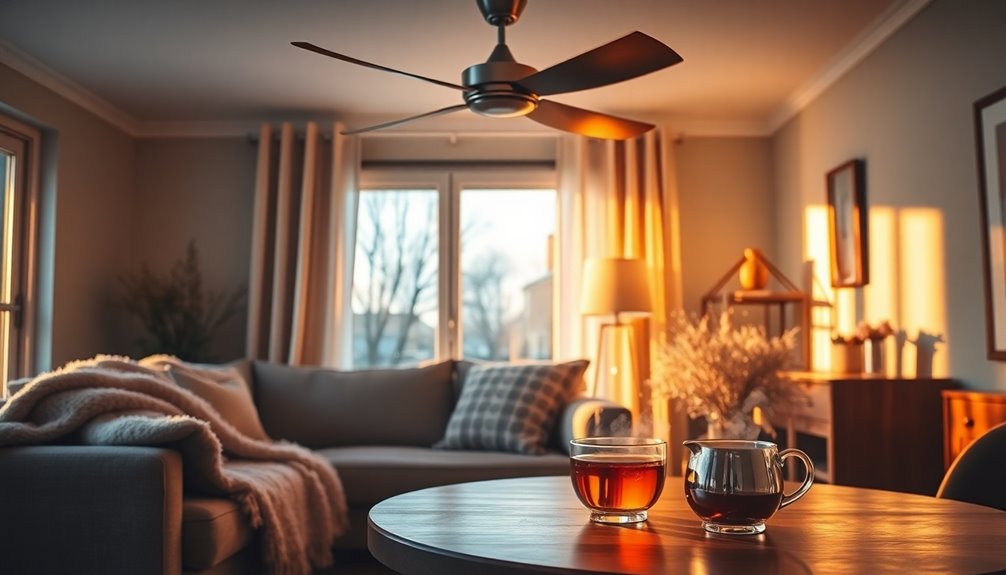
When you switch your ceiling fan to winter mode, you're helping distribute warm air that tends to gather near the ceiling.
This simple adjustment not only enhances your comfort but can also save you money on heating costs.
Warm Air Distribution
Reversing your ceiling fan's direction for winter can greatly improve warm air distribution in your home.
When you set it to rotate clockwise, the fan creates an updraft that pushes warm air, which tends to rise and accumulate at the ceiling, back down into the living space. This enhanced air circulation guarantees a more even distribution of heat throughout the room, making it feel cozier during those chilly months.
By utilizing the reverse ceiling fan in winter mode, you're not only increasing comfort but also potentially achieving energy savings.
With the thermostat sensing the warm air sooner, you can reduce the furnace's run time, leading to lower heating costs. For best results, run your fan at a low speed to avoid cold drafts while still promoting effective air circulation.
Energy Cost Reduction
During the colder months, utilizing your ceiling fan in winter mode can lead to significant energy cost reductions. By simply flipping the ceiling fan switch to reverse, you create an updraft that redistributes warm air trapped near the ceiling back down into your living spaces.
This process enhances thermal comfort, allowing you to lower your thermostat settings without sacrificing warmth.
Using a ceiling fan consumes about 60 watts of energy, which is vastly more efficient than heating systems, typically drawing around 3,500 watts.
By maintaining a more consistent room temperature, you can reduce the run time of your furnace, resulting in utility bill reductions of 15% or more.
In fact, running your ceiling fan in winter mode can cut heating costs by up to 10%. Additionally, improved air circulation contributes to a more comfortable environment throughout your home.
Ceiling Fan Direction in Summer
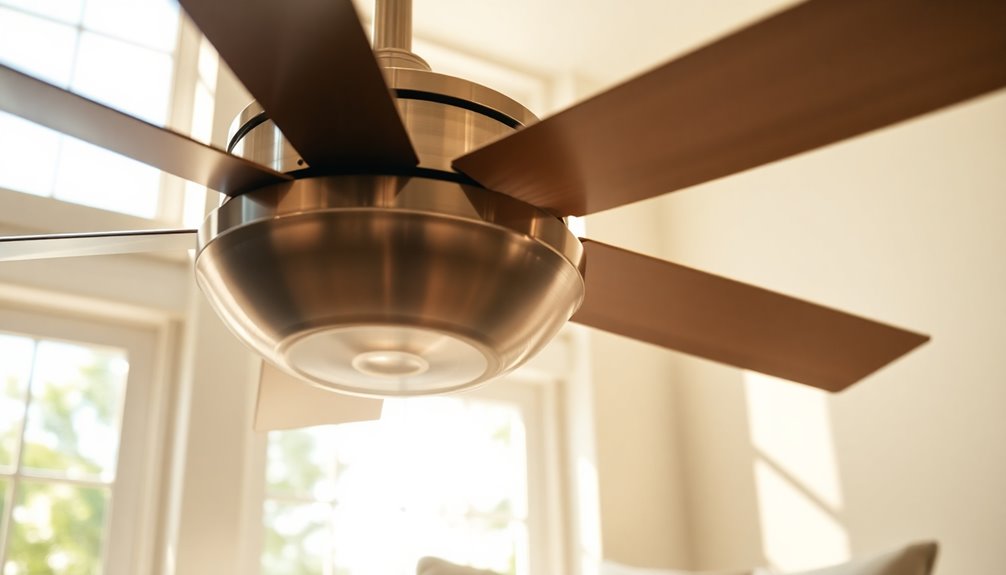
In summer, setting your ceiling fan to rotate counterclockwise is vital for maximizing comfort. This fan direction in summer creates a downdraft that pushes cool air downwards, enhancing the cooling effect in your room.
As the ceiling fan blades spin counterclockwise, they generate air movement that produces a rejuvenating wind-chill effect, making you feel cooler without actually lowering the room temperature.
To verify your fan is set correctly, stand under it and check if the air is blowing downwards. If it is, you've got it right! Running your fan at high speed can allow you to raise your thermostat settings by up to 4 degrees, leading to energy savings of up to 30%.
This means you can enjoy a comfortable environment while also being kind to your wallet. Properly setting your ceiling fan to counterclockwise in summer not only improves your comfort but also boosts the efficiency of your air conditioning system when used together.
Optimal Usage Times for Ceiling Fans
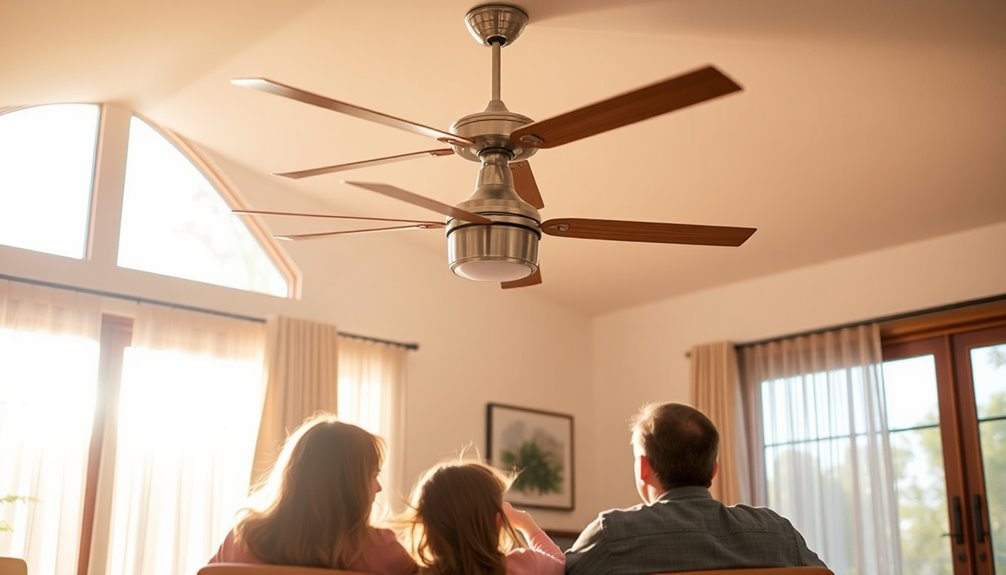
Optimizing your ceiling fan usage can greatly enhance your comfort throughout the day and night.
During the warmer months, running your ceiling fan in a counter-clockwise direction creates a rejuvenating breeze, delivering cooler air throughout the room. This can make those hot days more bearable and even reduce your reliance on air conditioning.
When dining, having your ceiling fan on can improve air circulation and keep the atmosphere pleasant, preventing stuffiness during meals.
At night, you'll find that a ceiling fan helps regulate temperature while you sleep, ensuring a comfortable environment without cranking up the thermostat.
In the winter months, don't forget to change the direction of your ceiling fans to clockwise.
This will help lower warm air from the ceiling, maintaining an even temperature and potentially lowering your energy bill. Additionally, keeping the area around the fan clear of flammable objects can enhance safety while enjoying its benefits.
Energy Savings From Reversal
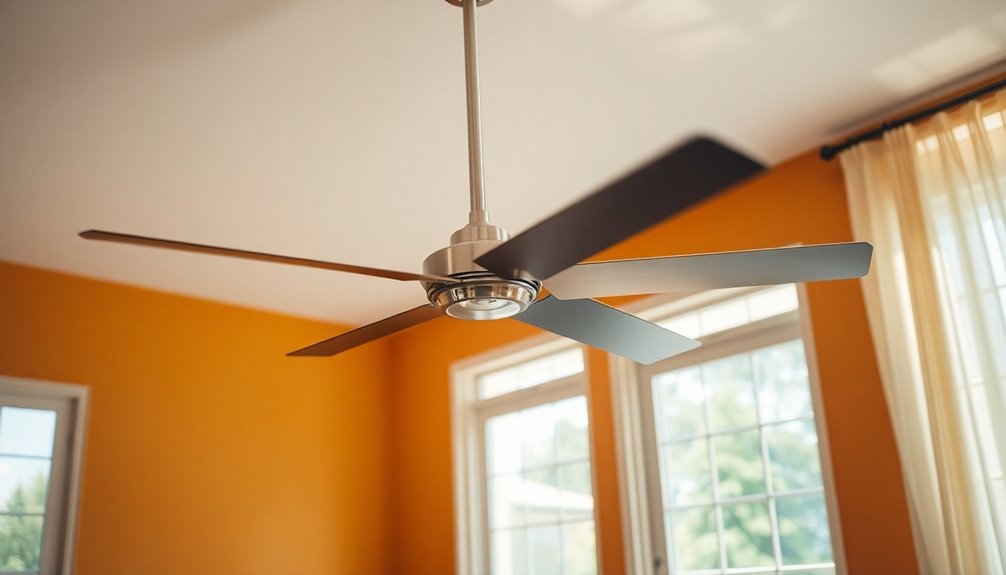
By reversing your ceiling fan in winter, you can lower your energy bills considerably.
It helps redistribute warm air that tends to rise, making your heating system work more efficiently.
You'll not only stay warm but also save money on your energy costs throughout the season.
Lower Energy Bills
Energy efficiency is a key factor in lowering your heating bills, and reversing your ceiling fan can play a significant role in that. By changing your ceiling fan's direction, you can effectively redistribute warmer air that rises to the ceiling, pushing it back down into your living space. This simple adjustment can help you reduce heating costs by up to 15%.
Ceiling fans consume only about 60 watts of energy, far less than the 3,500 watts used by typical air conditioning units. This means that utilizing your ceiling fan in winter not only enhances fan operation but also contributes to lower energy bills.
When your thermostat senses warmer air sooner due to this effective circulation, it results in less furnace run time, translating to further savings.
Additionally, maintaining a higher thermostat setting while reversing a ceiling fan can lead to even more energy savings, as it helps distribute warmth evenly throughout your home.
Efficient Heat Distribution
Reversing your ceiling fan to a clockwise direction in winter can make a noticeable difference in how heat is distributed throughout your home. When you do this, the fan creates an updraft that pushes the warm air, which typically accumulates near the ceiling, back down into the room. This improved air circulation helps maintain a consistent temperature, making your space feel cozier. Additionally, utilizing this technique can help mitigate the risks associated with heat pump failure, ensuring your home's heating system operates efficiently.
Not only does this technique enhance comfort, but it also leads to significant energy savings. With your ceiling fan running, your thermostat senses the warmer air more quickly, which can reduce your furnace's run time. In fact, you could save up to 15% on your heating bills just by using your fan effectively. Energy-efficient heat pumps can further complement this strategy by providing an additional source of warmth without increasing your energy consumption. Furthermore, HEPA filters in air purifiers can improve overall air quality, adding to the comfort of your living space.
Additionally, when combined with a geothermal heat pump, this approach can drastically enhance your home's energy efficiency. Ceiling fans consume around 60 watts of energy, a fraction of what heating systems use. By utilizing your ceiling fan in winter, you lower your reliance on those costly heating systems, allowing them to work more efficiently.
Mechanism of Fan Reversal
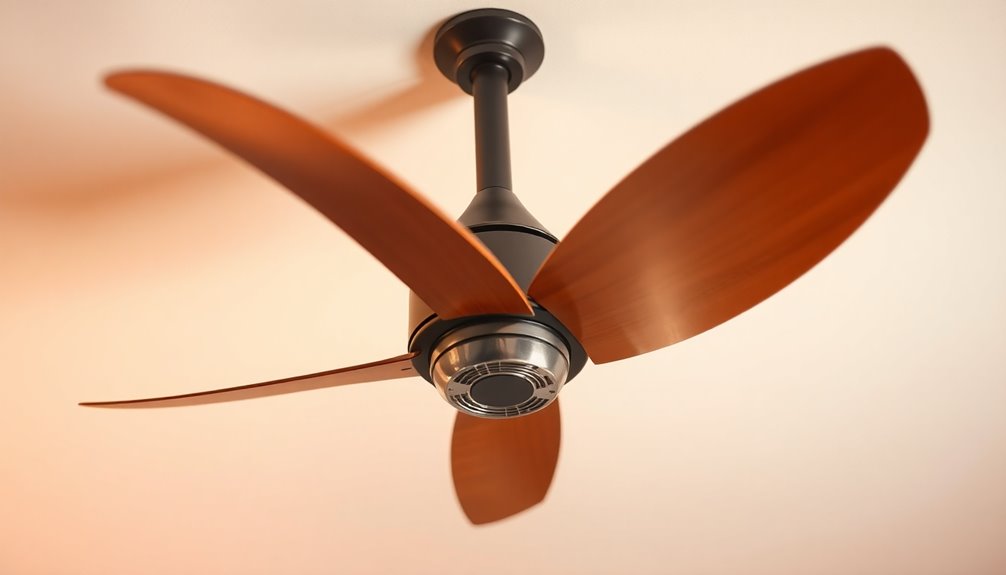
Most ceiling fans come equipped with a mechanism that allows you to easily change the rotation direction of the blades.
This simple switch can greatly enhance your comfort throughout the year by adapting to seasonal needs.
Here's how it works:
- Counterclockwise Direction: In summer, flipping the switch to this direction pushes cool air downward, creating a revitalizing breeze that promotes evaporation on your skin.
- Clockwise Direction: In winter, switching to this direction draws cooler air up, allowing warmer air that has risen to the ceiling to be pushed back down towards you, improving thermal comfort.
- Enhanced Air Circulation: Understanding this mechanism helps improve your heating and cooling efficiency, which can reduce energy costs.
Importance of Fan Size
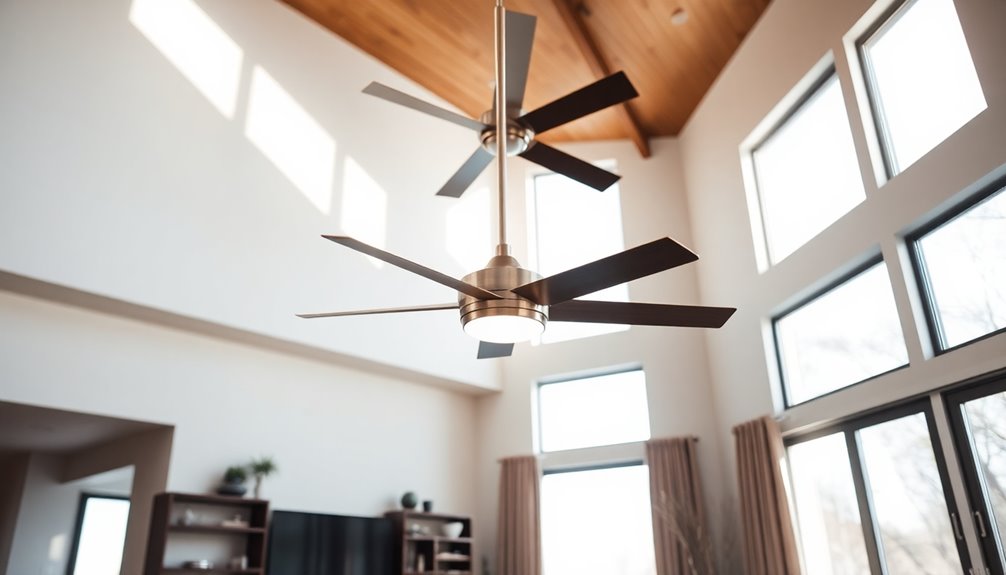
Choosing the right size ceiling fan can greatly enhance the effectiveness of your cooling and heating efforts. The ceiling fan size is vital because it directly impacts air distribution in your room.
For spacious areas like living rooms, a fan that's 50-54 inches is ideal, guaranteeing you can run your fan efficiently to circulate cool air. In contrast, a 44-inch fan works best for average-sized bedrooms or kitchens, providing effective cooling without wasting energy.
If your fan is too small, it struggles to circulate air effectively, while a fan that's too large can create excessive turbulence, making your environment uncomfortable. Additionally, consider your ceiling height when selecting a fan. Higher ceilings may require larger fans or down rods to maintain maximum airflow and safety.
When you choose the right ceiling fan size, you're not just enhancing comfort; you're also improving energy efficiency. This means reduced utility costs and a more sustainable home.
Professional Assistance and Guidance

Seeking professional assistance can be a game-changer when it comes to enhancing your ceiling fan's performance. HVAC professionals provide expert guidance on essential factors that improve your home's comfort while saving on energy costs.
Here's how they can help:
- Ceiling Fan Direction: They'll help you understand the best rotation for different seasons, promoting efficient air circulation. This can lead to better energy efficiency in your home, ultimately contributing to the overall performance optimization of your heating and cooling systems. Additionally, they can recommend insulation upgrades that further enhance your home's energy performance. Proper insulation can significantly improve the effectiveness of heat pumps, ensuring that your heating and cooling systems operate optimally.
- Energy Consumption: Professionals can show you how proper fan usage impacts your heating and cooling costs, potentially saving you money.
- Fan Switches: They'll educate you on correctly using fan switches to reverse direction, ensuring your fan operates at peak efficiency.
Additionally, they can advise on how effective home security systems can also contribute to overall household safety and comfort.
Frequently Asked Questions
What's the Point of Reversing a Ceiling Fan?
Reversing a ceiling fan isn't just a quirky adjustment; it plays an essential role in your comfort and energy savings.
In winter, you'll want warm air circulated downwards for a cozier space, while in summer, a counterclockwise spin creates that invigorating breeze you love.
With simple switches on most fans, it's easy to adapt to the seasons, helping you maintain a comfortable environment while keeping your energy costs in check.
Is It Better to Reverse the Fan or Forward the Fan?
It's generally better to reverse the fan based on the season.
In winter, running it clockwise helps circulate warm air, making your space cozier and more efficient.
Conversely, in summer, you want it to run counterclockwise to create a cooling breeze, allowing you to raise your thermostat.
Adjusting the fan direction based on seasonal needs maximizes comfort and can greatly reduce your energy costs, so it's worth the effort.
Does Reversing the Ceiling Fan Make a Room Warmer?
Imagine wrapping yourself in a warm blanket on a chilly day.
Reversing your ceiling fan can definitely make your room feel warmer. When you set the fan to rotate clockwise, it pushes the warm air that gathers near the ceiling down towards you.
This gentle circulation not only creates a cozy atmosphere but also helps eliminate cold spots, making your space feel inviting and comfortable throughout those cold winter months.
Why Do You Need a Reverse Fan?
You need a reverse fan to improve your home's comfort and energy efficiency.
By running your ceiling fan in reverse, you circulate warm air that gathers near the ceiling, making your space feel cozier without cranking up the heat.
This adjustment can help lower your heating costs and maintain a consistent temperature throughout the room.
Plus, it prevents that annoying cold draft while ensuring you enjoy the warmth where it counts.
Conclusion
So, you thought a ceiling fan was just for summer, right? Ironically, by simply flipping that switch to reverse it in winter, you can cozy up your space while saving energy. Who knew a little fan could wield such power? Embracing its seasonal versatility not only keeps you comfortable but also showcases your savvy side. So, the next time you feel chilly, remember: sometimes it's the simplest adjustments that bring the biggest benefits. Go ahead, give it a whirl!

